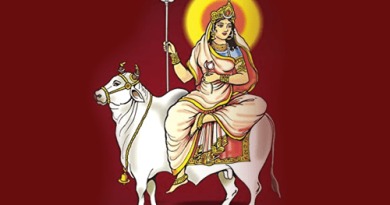About the Goddess of purity in Hinduism:
The eighth incarnation of goddess Durga, Mahagauri (one of Navadurga), is worshipped on the eighth day of Navratri. She is seen as having the ability to grant her followers’ wishes and end their pain.
Mahagauri has four arms, with the lower right arm remaining in the Abhaya Mudra (a gesture of courage), the upper right holding a trident, the lower left holding a damaru (a miniature hand drum), and the top left holding the Varada Mudra (gesture symbolizing giving out of boons).
Regarding the history of Mahagauri, there are two tales:
Shumbha and Nishumbha were two Asuras in the Devi Mahatyam who could only be destroyed by a female offspring of Goddess Parvati. As instructed by Lord Brahma, Lord Shiva turned Goddess Parvati’s skin black in order to carry out this act, giving her the name Kali, which means “goddess of death or time.”
Parvati underwent tremendous penance in front of Lord Brahma after receiving taunts about her complexion. He suggested she take a soak in the Himalayan Manasarovar River. After a bath, the goddess’s dark skin peeled away from her body and revealed itself to be Kaushiki (an affiliation of Shakti). Parvati as a result shown to have a fair complexion and was given the name Mahagauri (Maha = great, Gauri = white).
She (Parvati) once more took the guise of Kali in order to kill the Asura by giving Kaushiki her fair skin. Then, Goddess Kali became into Chandraghantha (Chandi). The name Chandragantha refers to a bell-shaped half-moon. Then, Dhumralochan was murdered by Goddess Chandi.
Then, the goddess Chamunda emerged from Chandi’s third eye. A terrifying variation of Chandi, Chamunda is one of the seven Matrikas. Asuras Chanda and Munda, who were working for Shumbha, were murdered by the goddess Chamunda. Then, the goddess Chandi changed into Kalratri, the seventh of Parvati’s nine avatars, in order to destroy the asura Raktabija, who had joined Shumbha and Nishumbha in battle. Later, Shumbha and Nishumbha were killed by Kaushiki. She then combined with Kali to change back into Mahagauri.
About her married life:
In several writings, a different story is given in various formats. In order to win Lord Shiva as her husband, Goddess Parvati underwent a difficult penance. She was covered in mud and dust during this, which darkened the colour of her skin. Her dedication pleased Lord Shiva, who made a marriage proposal to her. Lord Shiva allowed the Ganga’s holy waters to flow from his matted hair to purify Parvati’s body of the accumulated grime. She was made gorgeous and glorious by the sacred and holy waters of the Ganga, which removed all of her impurities. Mahagauri, which translates to “very fair,” was her previous name.
Worship and Mantras
The eighth day of Navaratri is devoted to the worship of Mahagauri. Mahagauri is always a 16-year-old. The night-blooming jasmine is the proper flower to utilize during the pooja of Goddess Mahagauri. On this holy day, women typically feed the unmarried girls as a sign of their devotion to Goddess Mahagauri.
The Mahagauri mantra to worship can be chanted as:
ॐ देवी महागौर्यै नमः॥
Om Devi Mahagauryai Namah||



